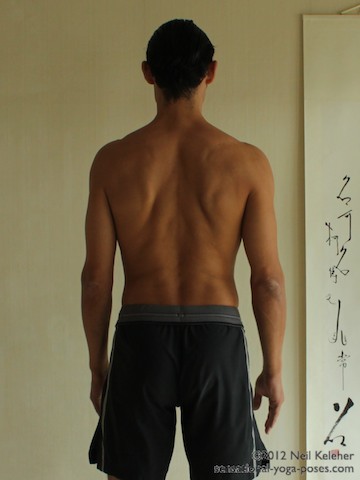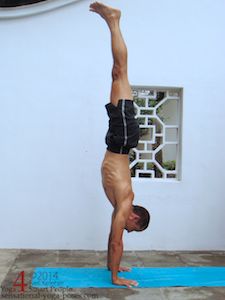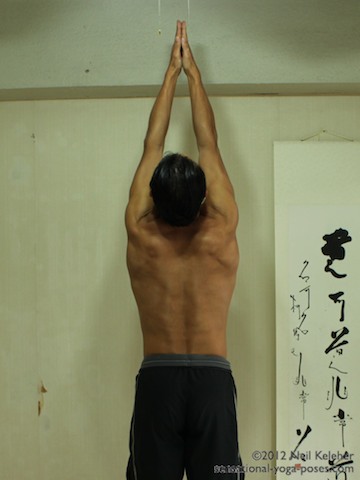The Trapezius Muscle
Using it in Lifted Arm Yoga Poses (And Controlling it with the Arms Down)
On page cat links
Arm overhead
Arm over the head yoga poses that use the trapezius muscle to lift and rotate the shoulder blades include warrior 1, chair pose, the arm lifting movements in sun salutation a and sun salutation b. Yoga poses where the trapezius helps to support the weight of the body with the arms reaching past the head include downward facing dog and handstand.
In arm over the head (or reaching past the head) yoga poses the bottom tip of the shoulder blade has to rotate outwards and upwards so that the arm has room to move upwards.
The trapezius muscle, along with the serratus anterior muscle, has a major role in this action.
But first lets look at the shoulder blade and how it should rotate when the arms are lifted.
The acromion Process
The shoulder socket is located on the outer edge of each shoulder blade. Just above the shoulder socket and projecting outwards is the acromion process (Acromion is greek for "Highest Point"). It's the bony bit that you can feel at the top of each shoulder. It's also where the shoulder blade connects to the collar bone.
If the shoulder blade didn't rotate when an arm is lifted, the upper arm bone (humerus) would press towards acromion process, compressing soft tissue between them. This is less than ideal.
It's because of this projection that the bottom tip of the shoulder blade has to rotate outwards and upwards when lifting the arms. Actually, the whole shoulder blade rotates in this fashion, it's just that looking at the bottom tip of the shoulder blade is one of the easiest ways to see this action.
Visualizing Shoulder Blade Rotation When the Arms Lift Up
If you stood behind someone and placed a hand, with fingers pointing upwards, on each of their shoulder blades as they raised their arms, you hands would move with their shoulder blades. Ideally your hands would move upwards and outwards, and the pinky side would lift slightly more than the thumb side. Your hands would be turning inwards.
Because the shoulder blade slides upwards and outwards as the arms are raised, the shoulder socket moves forwards as well as upwards. And as the shoulder blades rotate, the bottom edge of the shoulder socket moves outwards more than the upper edge so that the shoulder socker turns upwards for better contact with the ball of the arm bone.
The Trapezius Muscle Can Be Divided into Three Parts
The trapezius muscle, like the serratus anterior, can be divided into three parts with each part having a slightly different function.
The upper part attaches at the base of the skull and from there its fibers attach to the outer end of the collar bone. These fibers can be used to pull up on the outer edge of the collar bone, and since this attaches to the acromion process, these fibers also create an upward pull at the outer edge of the shoulder blade. In combination with the levator scapulae, whose fibers attach to the inner edge of the shoulder blade, they can be used to lift the shoulder blade without it rotating. This is useful when the arms are down by the side (as opposed to winging out as in the picture below.)
The middle part of the trapezius attaches to the spine from C7 down to T5 and from there to the upper edge of the scapular ridge.
These fibers can be seen contracting in the second picture below.
In these two pictures it's easy to see how the bottom tips of the shoulders move outwards when the shoulders are lifted.
The lower fibers attach to thoracic vertebrae T6 through to T12 and from there to a tubercle on the scapular spine, close to the inner border of the scapula. These fibers pull down on the inner edge of the shoulder blades.
Widening the Shoulder Blades so the Trapezius Muscle Has Room to Contract
For both the middle fibers and the lower fibers, extra room for contraction can be created by widening the shoulder blades. That's where the serratus anterior muscle can come into play. So that this muscle has room to contract, and a firm base from which to contract from, it helps to lift and expand the front of the ribcage. Opening the chest can be made easier by lengthening the neck. And both actions together can make it easier to stabilize the shoulder blades.
Lifting the shoulder blades with arms down
To practice lifting the shoulder blades in isolation, first practice lengthening the neck. Then with the neck long lift the shoulders. So that this exercise prepares you for the arm lifting exercise that follows, focus on pulling up on the bony crown of each shoulder. Allow your arms to wing out to the side as you do so. Then relax and repeat.
Try to draw your the peaks of your shoulders to the same height as your ears. This will help to activate the middle fibers of the trapezius.
To activate the upper fibers, focus on pulling up on the outer end of each collar bone.
Lifting the shoulder blades with arms up
Next reach your arms up over your head. Start with your elbows and fingers slightly bent and relax your shoulders. Lengthen you neck, open your chest, and reach the outer part of your shoulders upwards as you inhale. Then relax as you exhale.
Work at bringing the hands closer and closer each repetition. To make it easier to bring the hands together lift your shoulders and make your arms feel long.
You may or may not find it extra helpful to also pull up on the collar bones.
To make your arms feel long, straighten your elbows as you reach your arms up. Straighten your fingers aswell. Then focus on making your elbows and fingers feel straighter.
Pull your shoulder blades apart (away from each other)
If you've already done the serratus anterior muscle awareness exercises you can ideally already feel the inner edges of your shoulder blades. You can use that same awareness in this exercise. Pull the shoulder blades apart as your raise the arms.
And so that you activate the lower fibers of the trapezius muscle pull the inner edge of your shoulder blades downwards.
Yoga Poses where the Arms Reach Past the Head
You can practice these actions while doing yoga poses like warrior 1 and chair pose. If you need to start with the hands separated and work at slowly bringing them towards each other as you lift your shoulders and lengthen your arms.
Using the Trapezius Muscle in Down Dog and Handstand
This same action can also be utilized in downward dog and hand stand.
In both of these yoga poses the arms are about shoulder width apart. But since the arms reach past the head you can focus on making your neck long and chest open so that you can easily recruit the middle and lower fibers of the trapezius muscle.
In downward facing dog you can practice using your trapezius muscle to move your ribcage away from your hands.
Start with the trapezius relaxed, or slightly relaxed, and then move your shoulders towards your head so that you push your ribcage back. Do this while inhaling and relax while inhaling. You can also try the same exercise in handstand (perhaps while doing handstand against a wall.)
In both of these poses, because the arms are bearing some or all of the weight of your body you may find that the amount your shoulders lift differs from when you are standing and doing the same exercise (where the arms aren't bearing weight).
By playing with your trapezius muscle in this way you can find the amount of activation that feels just right.
Using the Trapezius Muscle in the First Movement of Sun Salutation A
In sun salutation a the first movement is to sweep the arms up over the head. (In sun salutation b, this same arm movement is used, but the knees are bent at the same time.) If moving the arms out to the sides as you lift them, you can practice lifting your shoulder blades higher as you lift your arms. And if you keep your neck long you can also look up as you lift your arms.
With your arms out to the sides, start with the shoulders relaxed and then widen them and make your arms feel long at the same time.
Then slowly lift your shoulders and arms at the same time to the point that your hands touch over your head.
Then lower arms and relax your shoulders at the same time.
When bending the neck backwards at the same time as lifting the arms, you may find your neck is more comfortable if you focus on making it feel long. Also, rather that letting your head fall back, work at making the back bend of the neck active.
Use your spinal erectors.
Published: 2020 08 28
Updated: 2013 01 07



















